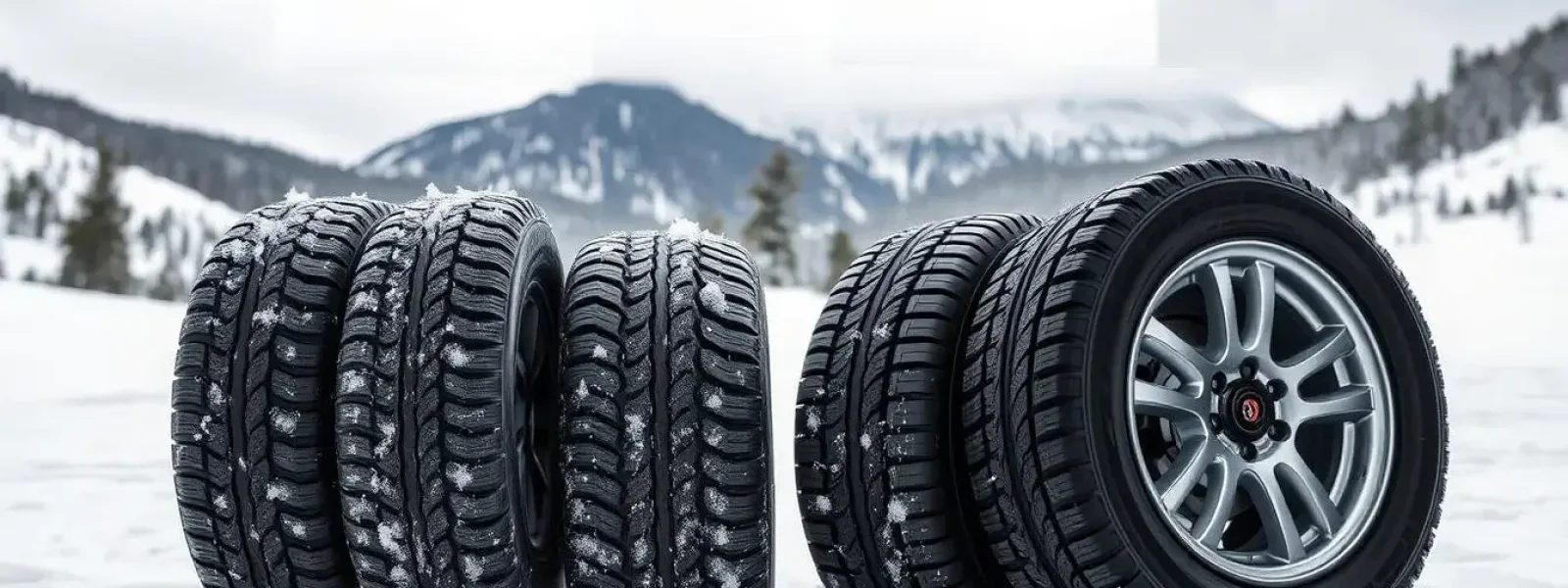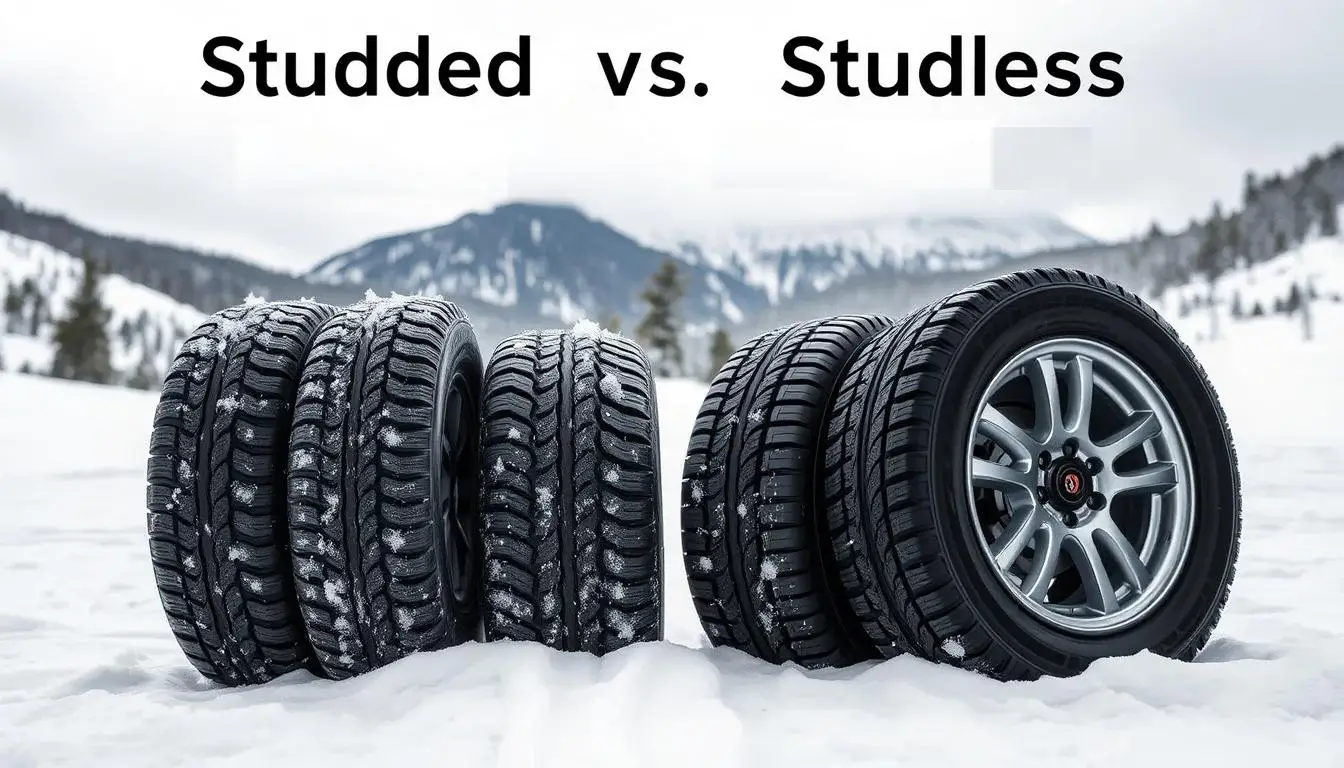Are you ready to face winter’s icy roads? The right tires can make a huge difference. But how do you choose between studded and studless winter tires?
Winter tires are essential for safe driving in snow and ice. They offer better traction when it’s cold. But, many drivers are unsure about studded vs studless winter tires.
Studded tires have metal studs for extra grip on ice. Studless tires use special rubber and designs for snowy roads. Both have their benefits, but which one is best for you?
In this guide, we’ll look at studded vs studless winter tires. We’ll talk about their performance, cost, and help you decide. Let’s find out which tire will keep you safe on cold roads!
Key Takeaways
- Winter tires significantly improve traction and handling in cold conditions
- Studded tires excel on ice but may have limitations on bare roads
- Studless winter tires offer versatile performance across various winter conditions
- The choice between studded and studless depends on your local climate and driving needs
- Winter tires typically last 35,000 miles or 4-5 seasons with proper care
- Investing in winter tires can cost between $600 to $1,000 for a set of four
- Switching between winter and all-season tires is recommended twice a year
Understanding Winter Tire Technology
Winter tires are key for safe driving in cold weather. They use special rubber compounds that stay flexible in cold temperatures. This flexibility helps keep grip on icy roads.
Winter Tire Compounds and Materials
The rubber in winter tires often includes silica. This ingredient boosts wet traction, keeping you safe on slushy roads. Some tires also have metal studs for extra grip on ice.
Tread Patterns and Design Features
The tread pattern of winter tires is made for snow and ice. Deep grooves help push snow and slush away. Sipes, small slits in the tread blocks, create biting edges for better traction.
The Role of Temperature in Tire Performance
Temperature greatly affects tire performance. Winter tires perform best when it’s below 45°F. At this temperature, regular tires harden, losing grip. Winter tires stay soft, keeping traction in cold weather.
| Tire Feature | Purpose | Benefit |
|---|---|---|
| Silica-enhanced rubber compound | Improve flexibility in cold | Better grip on icy roads |
| Deep tread grooves | Channel snow and slush | Reduced risk of hydroplaning |
| Sipes in tread blocks | Create biting edges | Enhanced traction on snow |
Winter tires offer top performance in cold weather. They provide better traction, shorter stopping distances, and improved handling compared to all-season tires.
Studded vs Studless Winter Tires
Choosing the right tires for winter driving is important. Let’s look at studded and studless winter tires.
Metal Stud Technology and Function
Studded tires have metal studs in the tread. These studs help grip ice, making them great for icy roads. They can stop 15% shorter on ice than some studless tires.
Advanced Studless Tire Engineering
Studless winter tires use special rubber and tread designs. They’re quieter and don’t damage roads like studded tires. Some studless tires even do better in very cold temperatures and on packed snow.
Performance Comparison in Various Conditions
Studded tires are best on ice but might use more fuel on clear roads. Studless tires perform well on packed snow and in deep cold. Your choice depends on your local winter weather and driving needs.
| Condition | Studded Tires | Studless Tires |
|---|---|---|
| Ice | Excellent | Good |
| Packed Snow | Good | Excellent |
| Deep Cold | Good | Excellent |
| Noise Level | Higher | Lower |
| Road Impact | Higher | Lower |
Both types offer better traction than all-season tires in snow. Your safety is important. Choose the tire that fits your winter driving needs.
🚗 Need Studded or Studless Winter Tires? Get Them Delivered & Installed Easily!
Now that you understand the differences between studded vs studless winter tires, it’s time to choose the right ones for your driving conditions. Amazon offers top-rated winter tires at competitive prices, plus the convenience of professional installation services near you.
✅ Compare the best brands, find the right fit, and schedule installation—all in one place!
🔗 Shop Studded & Studless Winter Tires + Installation on Amazon
Performance Analysis in Different Winter Conditions
Winter driving needs tires that can handle tough conditions. Let’s see how studded and studless winter tires do in various situations.
On icy roads, studded tires are top-notch. Their metal studs give great traction, making braking and handling better. They’re a must for areas with lots of ice.
In deep and fresh snow, studless tires are often better. Their special rubber and tread patterns grip the snow well. Many drivers find they handle and stop faster in snow.
On wet roads and in slush, both types do well. But studless tires might edge out studded ones because they clear water better, reducing hydroplaning risk.
Noise is another thing to think about. Studded tires are louder, which can be uncomfortable. Studless tires are quieter but don’t lose out on winter performance.
| Condition | Studded Tires | Studless Tires |
|---|---|---|
| Icy Roads | Excellent | Good |
| Deep Snow | Good | Excellent |
| Wet Roads | Good | Very Good |
| Noise Levels | Higher | Lower |
Choosing between studded and studless tires depends on your area’s winter conditions. Think about average temperatures, snowfall, and icy road frequency. This will help you decide what’s best for your winter driving.
Cost and Maintenance Considerations
Choosing winter tires is more than just looking at how they perform. You also need to think about the cost, maintenance, and how long they last. Let’s dive into these details to help you make a smart choice.
Initial Purchase Investment
Winter tire prices vary a lot. The Bridgestone Blizzak WS90 costs between $113 and $269 per tire. The Michelin X-Ice Snow ranges from $112 to $490. For studded options, the Nokian Hakkapeliitta 10 Studded is priced from $134 to $471. If you’re on a tight budget, the General AltiMAX Arctic 12 is priced between $97 and $225.
Long-term Wear Patterns
Winter tires usually last 20,000 to 40,000 miles. How long they last depends on how you drive and the road conditions. The Bridgestone Blizzak WS90 has a tread depth of 11-12 inches, while the Michelin X-Ice Snow measures 10-11 inches. Rotating your tires every 5,000 to 7,000 miles helps them wear evenly and last longer.
Seasonal Storage Requirements
Storing your winter tires properly is key to keeping them in good shape. Keep them in a cool, dry place away from sunlight. Bad storage can shorten their life by up to 25%. Use tire bags or racks to keep them in shape and prevent damage.
Road Surface Impact
Studded tires can damage the road, leading to restrictions in some areas. They’re often only allowed from October to April. Studdable tires give you the option to add or remove studs as needed. The Nokian Hakkapeliitta 10 has eco-friendly studs that reduce road wear while improving ice grip.
| Tire Type | Road Impact | Noise Level |
|---|---|---|
| Studded | Higher | 5-10 dB louder |
| Studless | Lower | Quieter |
| Studdable | Variable | Depends on stud use |
By considering these factors, you can find winter tires that meet your needs for performance, cost, and maintenance.
❄️ Be Winter-Ready – Order Your Studded or Studless Tires with Installation Today!
Choosing between studded vs studless winter tires depends on your driving needs and road conditions. Whether you need extra grip for icy roads or versatile studless tires for snow and slush, Amazon makes it easy to find the perfect set. Plus, you can schedule professional installation in your area for a hassle-free experience!
🚙 Don’t wait for the first snowfall—get your winter tires delivered and installed today!
🔗 Find the Best Studded & Studless Winter Tires + Installation on Amazon
Conclusion
Choosing the right winter tires is key for safe winter driving. The debate between studded and studless tires depends on your driving conditions, vehicle, and local climate. Both types are better than all-season tires in winter.
Recent tests show interesting results. For example, the Continental VikingContact 8 stopped 6.12% shorter than the Goodyear UltraGrip Ice 3 on ice. But, the Goodyear UltraGrip Ice 3 stopped 6.36% shorter in wet conditions.
Studded and studless tires have their strengths. The Michelin X Ice North 4 (studded) stopped 12.06% shorter on ice than the Michelin X Ice Snow (studless). Yet, the X Ice Snow did better in wet conditions and was quieter.
Your choice should match your needs. Think about your driving conditions, vehicle, and climate. Remember, good tire care and safe driving are essential for winter safety.
❄️ Wondering if winter tires are truly necessary? Discover how winter tires improve traction, braking, and control on snow and ice, and find the best models for your vehicle:
🔗 Do Winter Tires Make a Difference? How to Choose the Best Ones?
FAQ
Are studless winter tires better than studded winter tires?
It depends on your driving needs and the sorts of roads you drive on. Non-studded winter tires work well on snow and pavement, offering reliable ice traction without damaging roads. Studded winter tires, like the General Altimax Arctic or Nokian Tyres Hakkapeliitta, perform better on solid ice and steep hills, but limit their use in areas where studs are restricted.
Can you stud non-studded winter tires?
Some type of winter tires are studdable, meaning you can add studs later. However, you cannot get studded tires from regular non-studded winter tires unless they are designed for it. If you’re considering your options, look for “studdable” tires when shopping.
Should I buy studded or non-studded tires?
If you frequently drive on solid ice, steep inclines, or coastal roads, studded winter tires may be the safest for your driving needs. If you mostly encounter plowed snow, compact snow, and wet pavement, then non-studded winter tires like Bridgestone Blizzaks are a better choice. Whichever you pick, ensure they fit your typical winter driving conditions.
What are the advantages of studded winter tires?
Studded winter tires improve ice traction by digging into compact snow and solid ice, giving you better control at intersections and crossroads. However, they create noise on dry roads and can wear down pavement, which is why some regions limit their use.
Can I mix studded and non-studded tires?
No, mixing studded and unstudded tires is unsafe. It can cause uneven handling, especially in FWD (front-wheel-drive) vehicles. For the safest winter driving experience, always use a full set of studded or non-studded tires.
How do studless winter tires perform on ice compared to studded tires?
Modern non-studded winter tires have improved ice traction, using advanced rubber compounds and special tread patterns. Brands like Nokian Tyres, Blizzaks, and General Altimax Arctic offer winter tires that are also effective on solid ice without studs. However, studded tires still have an advantage on steep and unplowed roads.
Are studded winter tires noisy?
Yes, studded winter tires are louder than non-studded options due to the metal studs clicking against the road. If you want a quieter ride, consider unstudded winter tires instead.
How long do studded winter tires last?
A set of studded winter tires typically lasts 3-4 winter seasons, but the studs wear down faster than the tread. After the last winter of full effectiveness, you may notice a need for studs again.
Do I need winter tires if my car has ABS brakes and all-season tires?
Yes! While ABS brakes help with stopping, they do not replace the grip of winter tires. Season tires are a compromise in extreme cold, and winter tires are also designed to remain flexible in freezing temperatures, providing better braking and acceleration on snow and ice.
How can I pick the safest winter tires for my needs?
Check out a tire buying guide before making a decision. Consider factors like:
✅ Your local road conditions (plowed, compact, or solid ice)
✅ Your vehicle type (FWD, AWD, or RWD)
✅ Whether your area limits studded tires
✅ Your driving frequency during the winter season
🔹 Using the right winter tires will ensure safer driving, better handling, and peace of mind during icy conditions.



